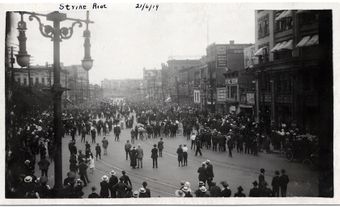
Background and Impetus
During the Second World War, labour shortages and increased production gave leverage to unions, who used it to gain concessions from corporate management (see Labour Organization). In Windsor, unionized Ford workers used wildcat strikes and walkouts to win small concessions during the war. When the fighting ended, veterans flooded the labour market, diluting the power that unions had built during the years of labour shortage. Ford management used threats of layoffs and a return to pre-war plant conditions to clamp down on their workers. The UAW knew that unless Ford formally recognized that the union represented the plant workers, many of their wartime advances would be lost. Following 18 months of negotiation with Ford and the Province of Ontario’s conciliation board, talks broke down and the UAW workers voted to strike.
The Strike
The strike began at 10 a.m. on 12 September 1945, when 11,000 plant workers from UAW Local 200 walked off the job. Local 200 president Roy England claimed that, in refusing recognition, Ford was trying to break the UAW. The union sought to make the Windsor Ford plant a “closed shop,” meaning that union membership was a requirement for employment. They also wanted the ability to deduct dues from workers’ wages, as opposed to collecting directly from the workers themselves, a time-consuming task that hindered union operations. The workers issued 24 demands, which included layoff and vacation pay, improved medical benefits and additional pay for work on Sundays and holidays. Although the majority of workers agreed with the strike, some workers who resisted were chased out of the plant and intimidated by the strikers.
The strikers relied on picketing and roadblocks to prevent non-union access to the plant and draw attention to their demands. Picketing went on for weeks, during which time the strikers forced Ford officials to move their offices off-site and the plant power house was shut off for the first time. On 5 November, the strike escalated when workers built a vehicle blockade cutting off access to the plant.
Strikers used about 2,000 vehicles — some stolen, some boxed in on the day of the blockade — to create a barricade that prevented an attack by the Ontario Provincial Police and the Royal Canadian Mounted Police ordered by the provincial and federal governments. On 5 November, Windsor City Council demanded that the blockade be moved on threat of involving the military. A separate union, Local 195, staged a sympathy strike in response to the ongoing agitation. Some 8,000 workers from 25 auto plants joined the strike for one month, with no strike pay. Many in the Windsor community supported the strike action, including returning soldiers, church groups and local businesses.
Arbitration and the Rand Formula
On 29 November, workers voted on the federal government’s suggestion that the union and management enter binding arbitration concerning the union dues and closed shop issues. They initially rejected the plan. By 19 December, union members voted in favour of third-party arbitration, and the strike officially ended after 99 days. Arbitration was assigned to Supreme Court Justice Ivan C. Rand, who sought to balance the demands of the two parties. Rand, who saw labour and employers as mutually codependent, criticized the conduct of both Ford and the strikers. In his decision, handed down 29 January 1946, Rand refused to grant the UAW mandatory worker membership (meaning the plant would not become a closed shop). Rand also ruled that all workers falling within the bargaining unit — whether they were actual union members or not — must contribute funds in the form of union dues, to pay the union’s costs of negotiating and administering the labour contract. The formula also required the company to deduct fees from employee wages and pass them on to the union in the form of dues.
Rand, who sought to stabilize the labour movement, outlined a series of penalties that would result from unauthorized strikes (such as the wildcat strikes and walkouts), and tied union leadership and corporate management closer together (see Rand Formula).
Significance
The Windsor Ford strike was one of the largest and most important postwar strikes in Canada. In addition to the public attention the strike drew, the resulting Rand Formula became a central facet of Canadian labour relations. The solutions offered by the Rand Formula provided a blueprint that has been used in numerous collective agreements in Canada and has been highly influential in shaping Canadian labour laws.
The Rand Formula is credited with taking “management-labour disputes out of the brick-and-tear-gas stage” and providing unions with a steady financial foundation. In the aftermath of the strike, Canadian unions became more hierarchical and bureaucratic and workers had less direct input on decision-making.
See also Strikes and Lockouts.

 Share on Facebook
Share on Facebook Share on X
Share on X Share by Email
Share by Email Share on Google Classroom
Share on Google Classroom

